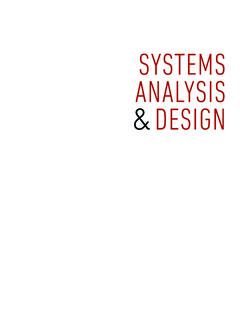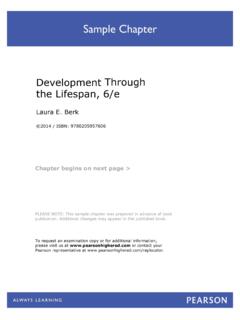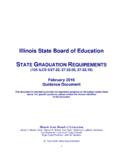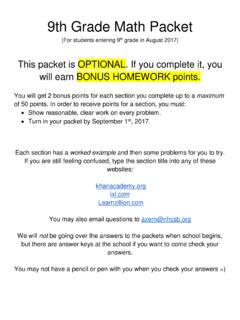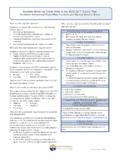Transcription of PPART ONE: Entering the World of Children’s LiteratureART ...
1 Entering the World of children s Literature 1 Introduction to the World of children s Literature PART ONE: PART ONE: Entering the World of children s Literature This pen and inkillustrationis an example of thesurrealist style. From Alice s Adventuresin Wonderland, written byLewis Carroll and illustratedby Sir John Tenniel. Page 1 11/06/12 10:56 AM Page 1 11/06/12 10:56 AM F-401F-4012 PART I: Entering the World of children s Literature One of my warmest childhood memories is of my mother reading Miss Pickerell Goes to Mars (MacGregor) to my older sister and me. We were in elementary school and quite capable of reading it ourselves, but we had grown accustomed to having our mother read to us each night before bedtime.
2 Stories sounded so much better when she read them. Another happy memory is of my sixth- grade teacher, Mr. Conway, reading a chapter a day from The Adventures of Tom Sawyer (Twain). The books he read that year helped pass the afternoons in the hot portable classroom. Each day we begged him to read one more chapter or even just two more pages because we could not wait to find out what happened next. Do you have similar memories of your parents and teachers reading to you? Because you are reading this book, you are most likely a teacher or a parent, or you intend to become a teacher or parent. This book will introduce you to the vast and wonderful World of children s literature, so you will be prepared to create such memories for the children in your classroom or your home.
3 In this textbook, when I talk about your children , I am referring both to students and to your own children . Within these pages I will acquaint you with numerous books appropriate for children from birth through age 13 the preschool and elementary school years. This textbook is intentionally brief; after all, most of your reading should be children s books not a book about children s books. Therefore, I will not attempt to cover the many fabulous books available for middle school and high school students ; several other good textbooks do focus on literature especially for adolescents and young adults ( , Donelson & Nilsen, 2008, and Brown & Stephens, 2007).
4 Defining Literature for children A few definitions will help outline the scope of this book. You might think children s literature could be easily defined as books for kids. However, there are many dif-ferent definitions of children s literature and even varying definitions for literature and children ! What is literature? Are all books literature? Are only stories considered litera-ture? One definition of literature requires that the work be of good quality (Hillman, 2002). Hillman describes some signs of poor quality stodgy writing with plots that are too predictable, too illogical, or too didactic. However, there is little agreement on what constitutes good quality. For example, the first time I taught an undergradu-ate multicultural literature course, I assigned Ishi, Last of His Tribe (Kroeber) for the biography reading.
5 I selected it because the book had affected me deeply, moving me to tears when the last members of Ishi s family died. However, my students were nearly unanimous in their reaction to the book: It stinks! I learned that quality is in the eyes of the beholder. I consider all books written for children to be literature excluding works such as joke books, cartoon books, and nonfiction works that are not intended to be read Page 2 11/06/12 10:56 AM Page 2 11/06/12 10:56 AM F-401F-401 CHAPTER 1: Introduction to the World of children s Literature 3from front to back, such as dictionaries, encyclopedias, and other reference material. It is true that some books are of better quality than others are, but one person cannot dictate to another what he or she ought to perceive as high quality.
6 It is an individual perception, which will develop as you read this textbook and some of the children s books that I believe are high quality. (I m hoping you don t think any of them stink!) To assist you, I describe many of the elements of quality children s literature in the next chapter. Additionally, the beginning of each genre chapter contains a set of evaluative questions you may ask yourself as you read the books. The information in Chapter 2 and the evaluation questions will help you refine your ever-developing judgment of quality books. Some people consider children s literature to span the age group of birth through 18. However, no junior high or high school students I know consider themselves children .
7 Therefore, I define literature for youth ages 13 to 18 as ado-lescent or young adult literature , and literature for youth from birth through age 13 as children s literature . Traditional elementary schools enroll children through sixth grade , and typically children are 12 or 13 years old when they completeelementary school. It is easy to distinguish between a kid in elementary school and one in middle or junior high school; it is even easy to distinguish between a 13-year-old and a 14-year-old, simply by asking them. But it is not so easy to distinguish between children s and adolescent literature. The definitions and dividing line are arbitrary at best, and sometimes children will surprise you when they cross over these lines with their reading selections.
8 When my adult students ask me how to determine what age or grade level a book would be suited for, I usually tell them that any book a reader likes is appropriate for that reader. When they do not accept that answer (which is most of the time), I tell them that one rule of thumb (also known as the quick and dirty rule) is that the author often makes the main character the age of the intended audience. Like most quick and dirty rules, this one is not always true. For example, the best-selling book Shane (Schaefer) is narrated by a young boy. However, the book s subject matter and readability are suited for young adults, and there was a great motion picture made about the book in the 1950s that appealed to all ages.
9 Some book publishers print an approximate reading level somewhere in their books. For example, Bantam indicates the level in the upper section of the copyright page, and Scholastic puts it on the lower portion of the back cover. In either case, look for the letters RL (Reading Level) followed by a numeral. For example, RL2 indicates a second- grade reading level. The level is written in this code so as not to turn away a child in an older grade who might wish to read the book. Keep in mind that reading levels are approximations determined by readabil-ity formulas that take into account only average lengths of words and sentences. Because the formulas cannot measure readers prior knowledge of the content or interest in the subject, they are often invalid.
10 For example, after my graduate students read The Devil s Arithmetic (Yolen), a book about the Holocaust, they engaged in a heated discussion about how early to introduce the book. Some Page 3 11/06/12 10:56 AM Page 3 11/06/12 10:56 AM F-401F-4014 PART I: Entering the World of children s Literatureargued sixth grade , but others said definitely not before eighth grade . Then one of the students raised her hand and said, I read it in third grade . That was the end of that discussion. I used to think that although some children were not able to read on their grade level, their interest level would be the same as that of their peers. One summer I took a group of preservice teachers to an inner-city school to tutor children in summer school.





